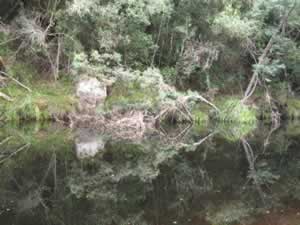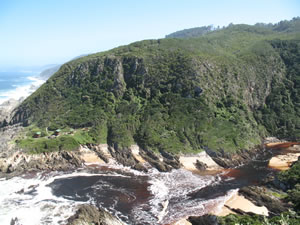This was no ordinary walk. They say it’s one of South Africa's most arduous and we had to book it a year in advance.
We knew we would be on our own. We had to get supremely fit and we had to plan; everything we were likely to need we had to carry. We took the view that the best way to plan was to think about climbing Everest and then cross off the bits and pieces that we may not need like oxygen and ice picks.
Our list was gradually whittled down from a small book to two tightly formatted sheets and then we allocated items to people (waterproof rucksack raft, Andrew, Kartoffelpuree, Sonja (she's
.
German and cooks), anti-venom kit Asnath, biodegradable soap, Santjie, etc).
Meanwhile Santjie's brother Dirk and sister-in-law Riana, down in George in South Africa, were independently planning their bit from a somewhat different perspective. Dirk would take two lagers and a can of bully beef for each day while Riana had to decide whether she would do it in boots or bare feet.
She eventually compromised; she would do it in bare feet but she would allow Dirk to carry her boots 'for in case'
The path took us along the massive cliffs of the Tsitsikama National Park along the coast for about 50 km going up and down crossing deep valleys, wading rivers and climbing kilometre high cliffs.
Before we set out we had to watch a video to put the wind up us to make us take the whole thing seriously. It made it clear that the main challenge was the Blaukrans river mouth which we had to hit within an hour or so of low tide if we were not to be thrown against the rocks when swimming and pulling our inflated rucksack bags across.
Twelve people were allowed to do the walk each day. We were eight and we were wondering who the other four were, not least because they did not turn up for the video intimidation session. We soon found out, they were a young Capetonian called Simon and three somewhat scantily dressed young mermaids who began the walk a pale shade of white but very soon assumed a deepening lobster colour. I sensed, with some avuncular concern, that they perhaps were not treating the whole exercise with the seriousness of purpose that it merited. Indeed, even Dirk occasionally raised a worried eye from his lager and bully beef, as, silhouetted on a rock against the South Atlantic sunset, the scanties got increasingly scantier. It was only later that I learnt that Simon had done it all before.
On the second day the chalets–there were two each containing two three-bed bunks–were near a crystal stream where I had found newt tadpoles. Seasoned readers of these letters will know that I have a particular interest in newt tadpoles as evidence of the crested newt (or of the dormouse) is the only surefire way of stopping Tescos opening a shop on a greenfield site next to your back garden.
While I was relaxing in the knowledge that the Tsitsikama Tescos was a non-starter, the others were watching one of the last 32 remaining Cape Clawless Otters performing in the waves just for their benefit. I did not think it wise at the time to share with them my private view that it was probably a plastic inflatable imitation that the Parks people lay on for visitors every day at that time to ensure that they go home fulfilled.
it would have been churlish, I felt, to disillusion them. The little newtlets, on the other hand, I explained, were exciting, genuine and really the highlight of the whole trip and I was genuinely extremely sorry they had not seen them.
Where everyone else saw the otter



